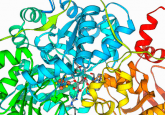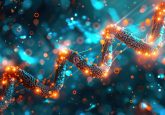A new era for proteomics?

Dr John Kellie is currently an Associate GSK Fellow and Investigator in the Bioanalysis, Immunogenicity, and Biomarkers group at GlaxoSmithKline (PA, USA). John received his Bachelor’s in Biochemistry from Indiana University (IN, USA) and his PhD in Chemistry from Northwestern University (IL, USA) studying top-down proteomics under Dr Neil Kelleher. He was a Post-Doctoral Scientist at Eli Lilly and Company (IN, USA) where he developed methods for intact protein quantification of a Parkinson’s Disease biomarker from human brain tissue. At GSK, John utilizes mass spectrometry for development and application of novel bioanalytical methods for biotherapeutic and protein quantification from preclinical and clinical samples.
Dr Thomas Angel is currently a Senior Scientific Advisor in the Bioanalysis, Immunogenicity, and Biomarkers group at GlaxoSmithKline. Tom received undergraduate degrees in biology (BS) and chemistry (BA) from California State University (CA, USA) and PhD from Montana State University-Bozeman (MT, USA). Tom’s research interests include applications of mass spectrometry for protein characterization and MS-based quantitative proteomics and its application to biomedical research. Tom has expertise in the biophysical characterization of integral membrane proteins, proteomics and applications of metabolic stable isotope labeling methods for quantification of proteome/protein dynamics.
Background
A decade ago in a basement lab in Urbana, Illinois (USA), it was common for several graduate students to sit and wait for automated protein database search outputs. The focus was not on drug characterization, target validation or systems biology; the sole focus was sheer numbers of protein identifications. Not for any specific purpose other than to show that we could. Analytical publications achieved proof-of-principle for systems or targeted biology applications but were really just long lists of protein identifications. Indeed, it was a focus in a few labs across the world, some with custom, manufacturer one-off, or other high-end mass spectrometry instrumentation. The academic proteomics ‘arms race’ was in full swing, with instrument vendors watching closely and collaborating with certain labs to try to gain a competitive advantage.
Identification and quantification of the proteins or proteoforms present in a biological sample evolved to provide a necessary foundation to generate insights into the complexities and emergent properties of biological systems under therapeutic modulation. Advances in mass spectrometry-based platform technologies (ion sources, optics, including trapping and manipulation and mass analyzer modalities [1,2]) coupled with improvements in a wide variety of sample preparation methodologies (isolation, enrichment and complexity reduction through fractionation) now provide the characterization and quantification of hundreds to thousands of proteins present in a biological sample [3,4]. While affinity-based protein arrays can provide high-throughput quantification, mass spectrometry is not limited to certain proteins and offers broad post-translational modification characterization capability. Commercialized mass spectrometry analytical platforms from major vendors (ThermoFisher Scientific; MA, USA, Bruker; MA, USA, Waters; MA, USA, Agilent; CA, USA, SCIEX; MA, USA, etc.) now enable analyses that provide critical information able to be used as checkpoints for drug discovery and development.
Thanks to such advancements, the arms race is (essentially) over: we have ultra-sensitive proteomic approaches, post-translational modification workflows and refined protein quantification capabilities [5–7]. The focus can squarely shift from development to application, but like a young adult sent into the world full of potential, proteomic analyses need further purpose and direction in application. Proteomic analyses need experts in the application fields partnered with trained analytical scientists as a two-way mentorship of sorts, in order to maximize that potential. While certainly not the only players, pharma preclinical and clinical bioanalytical groups and CROs will play a big role in the emerging proteomic space, and regulators will need to understand and ensure that proteomic data adequately supports relevant claims. Areas of drug discovery, protein network elucidation, biomarker discovery and pharmacodynamics are poised for emergence and will be briefly discussed.
Drug discovery and protein network elucidation
One of the first proteomics applications in pharma industry, the role of proteomics in drug discovery may be able to move out of specialized pharma groups or academic labs. As a drug discovery tool, proteomics may be used to help understand changes in protein profiles for disease states, test responses of model systems under therapeutic or genetic modulation and examine protein expression in relation to genomic studies for target identification. CRO appeal may be high due to opportunities for high profit margins, if proteomics is utilized as a widespread diagnostic screen in a platform format. Evidence of proteomics as a screening platform can serve as a model [8,9]. If a CRO already has liquid chromatography and high-resolution mass spectrometry instrumentation, the only new investments may be in data processing, experimental planning expertise and oversight necessary to ensure high quality, compliant data.
Proteins that have shared functional roles can offer clues to drug mechanism of action and play roles in drug discovery, biomarker discovery and pharmacodynamics. Global protein quantification has the ability to confirm previous systems biology evaluations of related proteins revealed from other analytical approaches in previous studies. A ‘one-stop-shop’ for protein network confirmation under control and experimental conditions can help at various stages of the drug discovery, development and delivery cycles. Large-scale utility with respect to breast cancer can be brought in to serve as models, and a key point moving forward will be translation of such projects in academia to application for drug research and development [10,11].
Biomarker discovery and pharmacodynamics
Proteomics analysis for cellular systems undergoing experimental drug therapeutic testing may yield identification of biomarkers useful for future assay development complementing already existing biomarkers. Higher-throughput sample workflows will enable testing of certain subsets/subtypes of preclinical or patient populations [12,13]. Additional, testing will be necessary to validate screening results, and entities interested in using proteomics for biomarker discovery applications should plan to have such biomarker validation tools in place if currently non-existent [14,15].
Pharmacodynamics, an indicator of system modulation due to drug therapy, plays a key role in drug development. Relationships between drug levels and protein, or protein family expression, or turnover, can provide a critical endpoint for candidate progression. A confident, statistically-backed confirmation of efficacy such as target engagement or modulating intended pathway to confirm mechanism of action, when added to existing milestone evaluations, may ultimately lead to better drug candidates in stage II and III clinical trials, as this was a key indication from the pipeline review at Pfizer (NY, USA) [16]. However, the use of proteomics and the data considered for establishing such endpoints should be thoroughly considered and evaluated beforehand, e.g. establishing which proteins or protein families will be considered and measured to indicate favorable pharmacodynamic response.
Historically, measuring molecular flux (synthesis and degradation rates of biopolymers) has led to critically important discoveries in biological sciences facilitating deep insight and understanding into fundamental biological processes such as heredity [17] and metabolism [18,19]. Isotopic tracer introduction allows for quantification of time-dependent changes and the determination of kinetic rate constants and the molecular constituents of associated pathways and networks. The combination of stable isotope labeling and mass spectrometry-based protein analysis represents a synergistic pairing of technologies enabling untargeted and targeted interrogation of protein dynamics of biological systems. Understanding protein dynamics or flux offers the potential to enable deeper insight into the complex biology that is causal in disease or reflects disease modulation and as such represent the next generation of protein biomarkers.
Directions for implementation of commercialized proteomic technologies
The aim of many reagent and sample preparation companies, instrument vendors and software developers has been largely to automate and simplify the preparation, acquisition and data processing steps involved in mass spectrometry. The marketing goals of streamlined, integrated path to an end product of proteomic data is appealing to new customer bases, but the same customers should be cognizant of the risks inherent to experiment planning; essentially, if you don’t know how to ask the right (experimental) question, you might get a misguided answer. The disconnect between fresh, unprepared sample and protein search output can be a chasm. Education (ideally vendor agnostic), analytical training (or talent on-boarding), and diligent data review (with connection to the raw data) can narrow the chasm to a manageable and less-risky state.
A few hurdles will need to be cleared for instances of new implementation of proteomics workflows in laboratories seeking to demonstrate proteomic applications in emerging areas. Education of both analysts and management will be essential. Topics of proteomic databases, identification and reporting statistically significance cut-offs, post-translational modification reporting, sample processing options, mass spectrometer operation, or proteomic experimental design may be foreign or under-appreciated in emerging proteomics labs. Training in areas of data acquisition and review may be necessary. Bench scientists will need to evaluate instrument performance over time, troubleshoot, and identify sample and data processing solutions. Data handling, particularly for CROs may need to be addressed on a case-by-case basis. For all labs, management will need awareness of data acquisition, access, retention, compliance, quality assurance and implication in filings.
- Nolting D, Malek R, Makarov A. Ion traps in modern mass spectrometry. Mass Spectrom. Rev. (2017).
- Zheng X, Wojcik R, Zhang X et al. Coupling front-end separations, ion mobility spectrometry, and mass spectrometry for enhanced multidimensional biological and environmental analyses. Annu. Rev. Anal. Chem. 10(1), 71–92 (2017).
- Angel TE, Aryal UK, Hengel SM et al. Mass spectrometry-based proteomics: existing capabilities and future directions. Chem. Soc. Rev. 41(10), 3912–3928 (2012).
- Keshishian H, Burgess MW, Specht H et al. Quantitative, multiplexed workflow for deep analysis of human blood plasma and biomarker discovery by mass spectrometry. Nat. Protoc. 12(8), 1683–1701 (2017).
- Kuljanin M, Dieters‐Castator DZ, Hess DA, Postovit LM, Lajoie GA. Comparison of sample preparation techniques for large‐scale proteomics. Proteomics, 17(1–2), 1600337 (2017).
- Navarrete-Perea J, Yu Q, Gygi SP, Paulo JA. Streamlined tandem mass tag (SL-TMT) protocol: An efficient strategy for quantitative (phospho) proteome profiling using tandem mass tag-synchronous precursor selection-MS3. J. Proteome Res. 17(6), 2226–2236 (2018).
- Tyanova S, Temu T, Carlson A, Sinitcyn P, Mann M, Cox J. Visualization of LC–MS/MS proteomics data in MaxQuant. Proteomics, 15(8), 1453–1456 (2015).
- Colangelo T, Polcaro G, Ziccardi P et al. Proteomic screening identifies calreticulin as a miR-27a direct target repressing MHC class I cell surface exposure in colorectal cancer. Cell Death Dis. 7(2), e2120 (2017).
- Parker CG, Galmozzi A, Wang Y et al. Ligand and target discovery by fragment-based screening in human cells. Cell, 168(3), 527–541. e529 (2017).
- Edwards NJ, Oberti M, Thangudu RR et al. The CPTAC data portal: a resource for cancer proteomics research. J. Proteome Res. 14(6), 2707–2713 (2015).
- Mertins P, Mani D, Ruggles KV et al. Proteogenomics connects somatic mutations to signalling in breast cancer. Nature, 534(7605), 55 (2016).
- Crutchfield CA, Thomas SN, Sokoll LJ, Chan DW. Advances in mass spectrometry-based clinical biomarker discovery. Clin. Proteomics, 13(1), 1 (2016).
- García-Hernández V, Sánchez-Bernal C, Schvartz D, Calvo JJ, Sanchez J-C, Sánchez-Yagüe J. Data for tandem mass tag (TMT) proteomic analysis of the pancreas during the early phase of experimental pancreatitis. Data Brief, 20, 779–783 (2018).
- Cominetti O, Núñez Galindo A, Corthésy J et al. Proteomic biomarker discovery in 1000 human plasma samples with mass spectrometry. J. Proteome Res., 15(2), 389–399 (2015).
- Keshishian H, Burgess MW, Specht H et al. Quantitative, multiplexed workflow for deep analysis of human blood plasma and biomarker discovery by mass spectrometry. Nat Protoc. 12, 1683 (2017).
- Morgan P, Van Der Graaf PH, Arrowsmith J et al. Can the flow of medicines be improved? Fundamental pharmacokinetic and pharmacological principles toward improving Phase II survival. Drug Disc. Today, 17(9–10), 419–424 (2012).
- Hershey AD, Chase M. Independent functions of viral protein and nucleic acid in growth of bacteriophage. J. Gen. Physiol. 36(1), 39–56 (1952).
- Schoenheimer R, Rittenberg D. Deuterium as an indicator in the study of intermediary metabolism. VI. Synthesis and destruction of fatty acids in the organism. J. Biol Chem. 114(2), 381–396 (1936).
- Buchanan JM. Biochemistry during the life and times of Hans Krebs and Fritz Lipmann. J. Biol Chem. 277(37), 33531–33536 (2002).
Our expert opinion collection provides you with in-depth articles written by authors from across the field of bioanalysis. Our expert opinions are perfect for those wanting a comprehensive, written review of a topic or looking for perspective pieces from our regular contributors.
See an article that catches your eye? Read any of our Expert Opinions for free.






